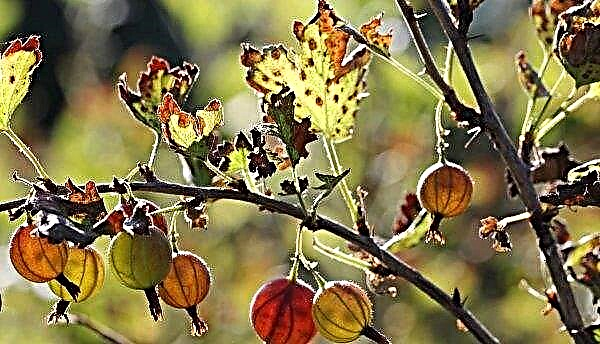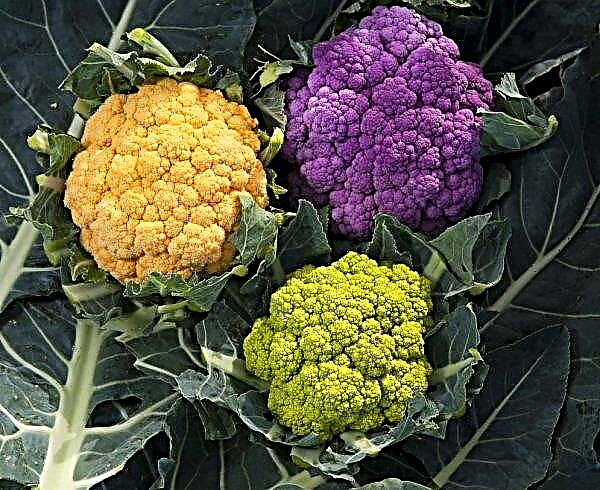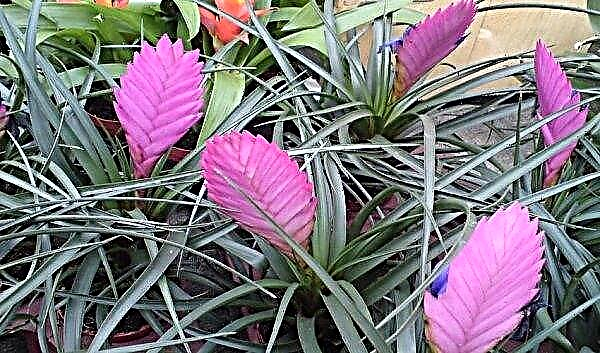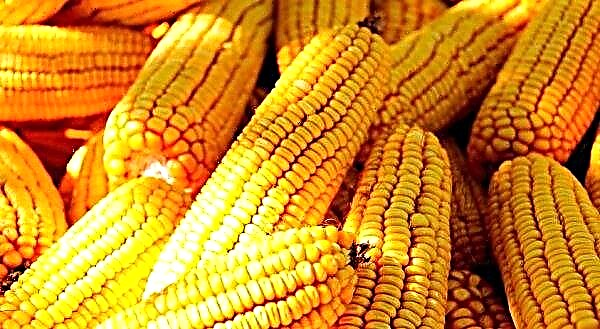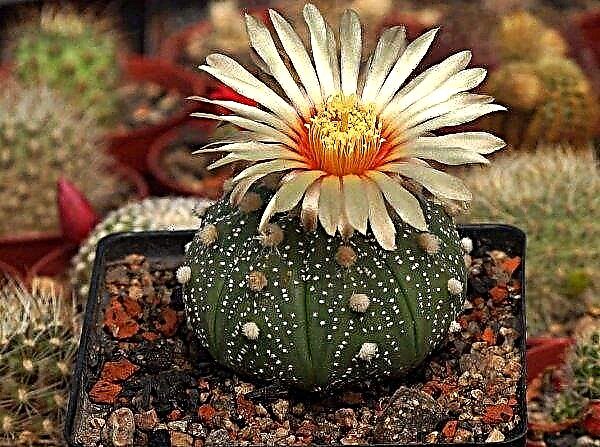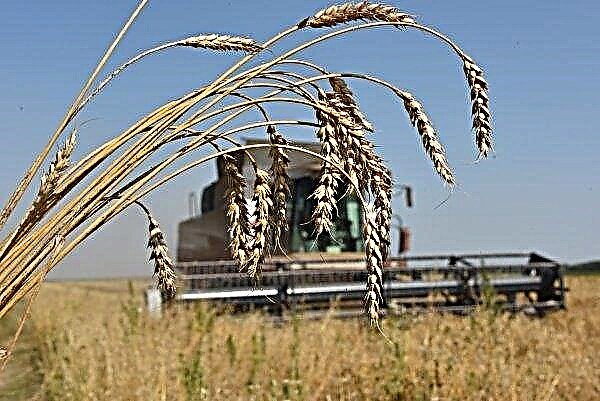The tomato variety Katyusha is perfect for those summer residents who do not have the ability to constantly control the growth and development of plants on the site. This early ripe hybrid can be successfully grown both in the greenhouse and in the open field, but in any case it will not require excessive efforts in the cultivation process. What you should know about the advantages and disadvantages of the variety and how to prevent mistakes in the process of growing tomatoes - this will be discussed later.
Characterization and description of the variety
Katyusha was first heard of the hybrid cultivar in 2001, when it was introduced into the State Register of Cultivated Plants as a cultivar recommended for planting in open and closed soil. Since that time, many gardeners have become convinced of its merits, so Katyusha, a large-fruited hybrid tomato, is increasingly found in areas. At the stage of full maturity, the fruits weigh at least 120 g each. All of them are characterized by pink or bright pink color and a rounded shape. Inside there are 6–8 chambers with seeds, in which about 5% of their composition is dry matter.
Did you know? The pulp of tomatoes contains a large amount of the so-called hormone of happiness - serotonin. This substance has a beneficial effect on the human nervous system, reducing depressive symptoms and improving mood.
The peel of the fruit is always dense and smooth to the touch, perfectly protects the tomatoes from cracking, and even during prolonged transportation. Subject to the requirements for growing vegetables from 1 m² of plantings, you can collect up to 7 kg of fruits with excellent taste characteristics: the pulp perfectly combines sweetness and a little sourness, with light spicy notes. Thanks to this, hybrid fruits can be used for the preparation of ketchup, tomato paste and various sauces, although their use is not excluded in fresh form (in salads). The growth of the plant itself varies from 80 cm in open soil and up to 1.3 m in the greenhouse.
Advantages and disadvantages of the variety
- The list of the main advantages of hybrid tomatoes Katyusha should include:
- high flavor characteristics of the fruit;
- good resistance to temperature changes during the cultivation process;
- excellent disease resistance;
- high reliability and transportability;
- good adaptive capabilities to changing growing conditions.
- Among the main disadvantages of tomatoes are:
- possible loss of taste (usually due to a violation of agrotechnical requirements during seedling care);
- increased fragility of stems;
- high demands on the nutritional compositions used during top dressing.
With proper care, the negative aspects of growing Katyusha varieties can be avoided, so the available disadvantages of the culture are the exception rather than the rule.
Optimal crop growing times
Planting a hybrid Katyusha variety can be performed both by seed and seedling methods, and the choice of a particular option depends more on climatic conditions and the region of growth. In the middle lane, 2 months before planting in open soil, the seeds are sown in small containers and left to germinate at home.
Important! If in your region the air temperature in May does not rise above + 15 ° C and return frosts are possible, then it is better to plant the grown tomatoes for a while in the greenhouse or arrange temporary shelter from the frame with a plastic film stretched over it.
Strengthened sprouts are transplanted to a constant place of growth not earlier than May, when the soil warms up well and the threat of return frosts passes. The total ripening period of tomato fruits is 100-110 days from the moment the first sprouts of the crop appear.
Growing Features
Tomatoes of the hybrid variety Katyusha grow faster if they are planted on the plot in seedlings, after germinating seedlings at home at a suitable temperature (not lower than + 18 ° C). Transplanting seedlings to the beds will also not take much time, especially when you consider all the recommendations for preparing the soil and performing the procedure itself.
Growing seedlings
The process of sowing tomato seeds for seedlings consists of the following actions:
- Find a suitable container (box or container) and fill it with a mixture of equal parts of garden soil, sand, humus and sheet soil. To fertilize the finished substrate, you can spill it with a solution of urea (10 g), superphosphate (30 g) and potassium sulfate (25 g), pre-mixed with 10 l of water.
- Prepared for planting seeds (you need to select only large and heavy specimens, without the slightest sign of damage), process in a weak infusion of potassium permanganate or growth stimulator, which will save them from fungal spores and activates the growth of rhizomes.
- In the soil poured into the container, make 2-cm deepenings and lay out the seeds slightly dried after processing.
- Sprinkle them with a small amount of soil and pour in moderately warm, settled water.
- To the soil sagging from moisture it is worth adding a little more earthen mix to the surface of the soil as level as possible.
- Cover the crops with dense polyethylene and remove them to a well-lit place with an air temperature not lower than + 22 ° С.
Further care for seedlings that emerged from the soil is based on timely moistening of the substrate from the spray gun (no crust should appear on the surface of the soil) and regular ventilation, by removing the shelter daily for 1–2 hours. After 2 weeks of such cultivation, the film can be completely removed, and as soon as 2 leaflets are formed on the plants, peck them in separate peat pots or disposable cups.
Important! Do not overexposure seedlings under cover. The polyethylene film and glass equally interfere with the normal growth of the culture, as a result of which the stems are curved, and the leaves have different sizes and shapes.
2-3 weeks before planting in open soil, the tomato sprouts begin to harden, daily carrying boxes to the balcony or terrace. Here they should stay at least 2-3 hours a day, gradually getting used to lower temperatures and wind.
Preparation of soil for planting seedlings
They begin to prepare the site for planting tomatoes of the hybrid variety Katyusha in the autumn, digging and loosening the substrate well in the chosen place. To increase its nutritional value, compost or humus can be added to the ground, as well as superphosphate (3 tbsp.), Potassium sulfate (1 tbsp.) And wood ash (2 cups), per 1 m² of territory. In too acidic soils, it is also useful to add dolomite flour or lime (for digging), since tomatoes of the described variety prefer more neutral soils.
With the advent of spring, the soil on the bed is again fluffed up, and then the landing sites of the grown seedling bushes are marked out, making holes at a distance of 50 cm from each other. Between adjacent rows should be at least 60 cm of free space.
Seedling Planting Technology
The process of planting grown seedlings in open soil consists of a set of standard actions:
- To begin, according to the above diagram, dig holes.
- Carefully remove young plants from seedlings.
- Place each of them in the center of the planting pit, straighten the rhizome and fill it with soil.
- Water the plantations with settled water and mulch the bushes with sawdust or peat.
 In addition, in regions with a high probability of return frosts, it is possible to additionally cover the plants with a film stretched on a metal frame base. It is good if the design used can be quickly disassembled, because if the weather stabilizes in a week, then it will not be difficult to remove it.
In addition, in regions with a high probability of return frosts, it is possible to additionally cover the plants with a film stretched on a metal frame base. It is good if the design used can be quickly disassembled, because if the weather stabilizes in a week, then it will not be difficult to remove it.Tomato bushes care
Almost immediately after transplanting seedlings into open (or closed) soil, further care for it begins. First of all, pay attention to fertilizer, watering, pinching and requirements for soil care under a growing crop.
Fertilizers and watering
First feeding Tomatoes of the Katyusha variety are carried out already a week after planting the plants at their constant place of growth. In this case, in a bucket of water you need to dissolve 1 tbsp. a spoonful of nitrophoska and 0.5 liters of mullein, and then distribute the resulting mixture at the rate of 1 liter per 1 bush. It is desirable to combine plant fertilizer with the next watering, thereby protecting the root system of the culture from burns.
Second feeding the tomato should be done shortly after the formation of the first flower brush. Now, to fertilize the variety, you can use 0.5 l of chicken manure, 1 tbsp. teaspoon of superphosphate and 1 teaspoon of potassium sulfate dissolved in 1 bucket of water. Third feeding usually occurs during the formation of the third flower brush and involves the use of a solution of 10 liters of water, 1 tbsp. tablespoons of potassium humate and the same amount of nitrophosphate.
Third feeding usually occurs during the formation of the third flower brush and involves the use of a solution of 10 liters of water, 1 tbsp. tablespoons of potassium humate and the same amount of nitrophosphate.
Did you know? The smallest tomatoes of our time can be considered “drop tomatoes”, bred in 2018 by the Israeli company Kedma. In fact, tomato fruits are more reminiscent of blueberries, though red or yellow.
As for irrigation, they should be moderate and carried out taking into account the state of the upper soil layer. In the rainy season, additional liquid injection is not required, and vice versa: waterlogging of the substrate threatens the gardener with unnecessary problems in the form of development of putrefactive processes and late blight.
Pasynkovka and formation of a bush
Many tomato varieties need timely pinching and garter shoots, without which it is possible to stretch and break the lashes, as well as chop their fruits. The hybrid plant variety Katyusha was no exception in this matter, and experienced gardeners recommend forming it into one stem (until the growth itself stops) or constantly changing the growth point, replacing it with side shoots. The choice of a specific method depends on the place of growing tomatoes (the second option is more typical for greenhouses), but in order not to get confused in the actions performed, you can form all the plants in one stem. It is not difficult to do this: when the first extra shoot appears under the central brush with inflorescences located on it, it must be removed immediately, and it is advisable until it reaches 5 cm in length. All subsequent formative actions are performed with an interval of 10–11 days, because it takes so much time for the new side branches to grow, but not outgrow.
It is not difficult to do this: when the first extra shoot appears under the central brush with inflorescences located on it, it must be removed immediately, and it is advisable until it reaches 5 cm in length. All subsequent formative actions are performed with an interval of 10–11 days, because it takes so much time for the new side branches to grow, but not outgrow.
Important! When choosing shoots for removal, leave only specimens with large and strong colors. The most suitable option is the presence of three brushes.
You can do stepsoning in the morning or evening, breaking off the extra shoots not under the root, but leaving a small stump about 2 cm long. This way you will prevent the formation of unnecessary stepsons.
Soil cultivation and weeding
Loosening of the soil and simultaneous removal of weeds from it does not exactly hinder the cultivation of tomatoes of the described variety, especially when it comes to young plants that have not yet matured and have not adapted in open soil. It is desirable to perform both procedures after the next wetting of the substrate, but without deepening the tool more than 10-15 cm in the thickness of the soil. In addition, always keep a certain distance and do not fluff the ground too close to the trunk of the bush. For weak plants, this may result in their removal from the ground. On average, soil loosening is performed once every 1-2 weeks or as necessary: as soon as a crust appears on the surface of the bed.
In addition, always keep a certain distance and do not fluff the ground too close to the trunk of the bush. For weak plants, this may result in their removal from the ground. On average, soil loosening is performed once every 1-2 weeks or as necessary: as soon as a crust appears on the surface of the bed.
Diseases and pests and their prevention
Despite the fact that the Katyusha hybrid tomato variety is highly resistant to certain diseases and pests (for example, cladosporiosis, fusarium and the tobacco mosaic virus), to minimize the likelihood of their manifestation, certain preventive requirements must be observed:
- adhere to crop rotation rules (do not plant these tomatoes after other tomatoes, potatoes, legumes and zucchini);
- Do not overmoisten the soil when watering;
- timely eliminate the problems that have arisen, possibly even with the use of chemicals.
One of the most common ailments of tomato bushes is late blight, which manifests itself in the form of brown spots on the leaves of plants or whitish plaque on its different parts. From one bush, the disease quickly spreads to the rest, so at the first sign of a change in the appearance of tomatoes, it is worth spraying the plants with a Bordeaux mixture, arceride or foundationazole, which can be purchased in almost any garden store (the instructions for use are always indicated on the package).
Among the diseases dangerous for the Katyusha variety, tobacco mosaic and powdery mildew can also be attributed. Their reason is a lack of nutrient components in the soil and an excessive amount of nitrogen and moisture, therefore, with timely feeding and the correct dosage of the selected formulations, the development of the problem will be avoided. Of the chemicals to combat these problems, Skor, Topaz, and Quadriis are more suitable than others. Do not exclude the possibility of reproduction of insect pests on the bushes of the Katyusha variety. Among the most famous in this case, one can distinguish the following:
Among the most famous in this case, one can distinguish the following:
- wireworm;
- a bear;
- scoop;
- Colorado potato beetle;
- aphids.
Features of harvesting and storage of crops
Hybrid tomatoes of the Katyusha variety ripen gradually, which means that the crop will have to be harvested in several stages, within 2-3 weeks or even months. Tearing the fruits from the bushes, they are neatly stacked in prepared boxes, and so that the fruits do not crumple, each layer can be re-paper. Fresh Katyusha tomatoes can be stored in the basement or in the refrigerator (with a small amount), but if the crop turned out to be rich, then it is advisable to process the tomatoes in the very first days after harvest until they have lost their taste. The described variety is able to maintain its characteristics even after heat treatment, so do not be afraid to preserve the fruit or bypass them in juice. The hybrid Katyusha variety is an excellent example of delicious mid-early tomatoes, which, due to their resistance to external adverse factors, receive more and more positive reviews from a variety of gardeners, and to make sure of their attractive characteristics you only need to plant seedlings on your site once.
The described variety is able to maintain its characteristics even after heat treatment, so do not be afraid to preserve the fruit or bypass them in juice. The hybrid Katyusha variety is an excellent example of delicious mid-early tomatoes, which, due to their resistance to external adverse factors, receive more and more positive reviews from a variety of gardeners, and to make sure of their attractive characteristics you only need to plant seedlings on your site once.

